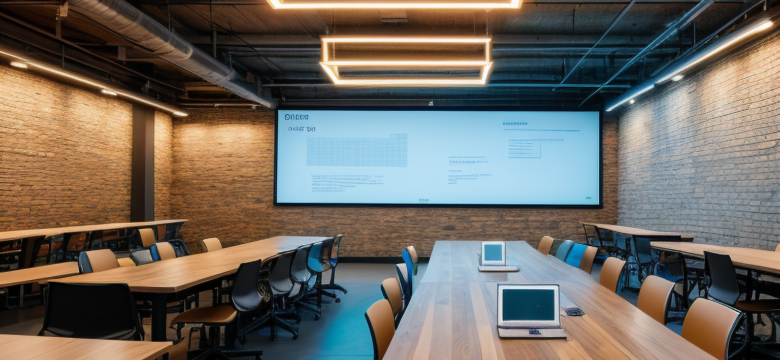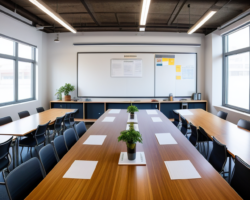This article explores innovative workshop concepts that are transforming educational practices, focusing on collaborative learning, technology integration, and experiential methods that engage learners in dynamic ways. In today’s fast-paced world, traditional teaching methods often fall short of capturing the attention of learners who crave more interactive and engaging experiences. Workshops are evolving to meet these needs, creating environments where participants can thrive through collaboration and hands-on activities.
Imagine walking into a room buzzing with energy, where learners are not just passive recipients of information but active participants in their education. This shift towards collaborative learning emphasises teamwork and communication, allowing participants to share ideas and perspectives. It’s like a potluck dinner—everyone brings something unique to the table, enriching the overall experience. Workshops designed with group dynamics in mind can foster a sense of community that enhances learning outcomes.
Moreover, the integration of technology into these workshops opens up a world of possibilities. From interactive platforms to virtual reality experiences, the tools available today can turn a standard workshop into an immersive learning adventure. Think of it as upgrading from a black-and-white movie to a blockbuster film—everything becomes more vivid and engaging!
As we delve deeper into these workshop ideas, we will uncover how experiential learning and innovative strategies like gamification are not just trends but essential components of modern education. Are you ready to explore how these concepts can shape the future of learning?
Collaborative Learning Environments
In today’s fast-paced world, collaborative learning has emerged as a cornerstone of effective education. Imagine a classroom buzzing with energy, where students are not just passive recipients of information, but active participants in their own learning journey. This approach encourages teamwork and enhances communication skills, allowing learners to engage in meaningful discussions and share diverse perspectives. When workshops are designed to foster group dynamics, they transform traditional learning into an interactive experience.
Furthermore, creating an environment where collaboration thrives involves several key elements:
- Trust and Respect: Establishing a safe space where participants feel valued promotes open dialogue.
- Clear Objectives: Workshops should have defined goals that guide collaborative efforts, ensuring everyone is on the same page.
- Diverse Groups: Mixing participants with varying backgrounds and skills can lead to richer discussions and innovative solutions.
By incorporating these principles, educators can design workshops that not only enhance learning but also prepare participants for real-world challenges. After all, in a world where collaboration is key, fostering these skills in a supportive environment is essential for success.
Technology-Enhanced Workshops
In today’s fast-paced world, integrating technology into workshops has become essential for crafting an engaging learning experience. Imagine stepping into a workshop where every participant is not just a passive listener but an active contributor, thanks to innovative tools and platforms. By leveraging technology, educators can create a dynamic environment that caters to diverse learning styles and backgrounds. The beauty of technology-enhanced workshops lies in their ability to break down traditional barriers, making learning more accessible and enjoyable for everyone involved.
For instance, tools like interactive whiteboards and collaboration software allow participants to brainstorm and share ideas in real-time. This not only fosters creativity but also encourages teamwork, as learners can easily collaborate regardless of their physical location. Moreover, platforms such as Zoom and Google Classroom have revolutionised the way we conduct workshops, enabling seamless communication and interaction among participants.
Additionally, technology opens the door to immersive learning experiences through simulations and virtual environments. This is particularly beneficial for complex subjects where traditional teaching methods may fall short. By engaging learners in a hands-on manner, technology allows them to apply theoretical concepts in practical scenarios, enhancing their understanding and retention.
However, it’s important to remember that while technology can significantly enhance workshops, it should complement rather than replace traditional methods. The key is to strike a balance, ensuring that technology serves as a tool for engagement rather than a distraction. In essence, technology-enhanced workshops are not just about incorporating the latest gadgets; they’re about creating a rich, interactive learning landscape where participants thrive.
Virtual Reality in Education
Imagine stepping into a classroom where the walls dissolve, and you find yourself in ancient Rome, walking alongside philosophers and warriors. Virtual Reality (VR) is not just a gimmick; it’s a revolutionary tool that is reshaping how we learn. By creating immersive environments, VR allows learners to explore complex subjects in a way that traditional methods simply cannot match. This technology offers a unique opportunity to engage students by transporting them to different worlds, making learning not only informative but also incredibly exciting.
In educational workshops, VR can be utilised for a variety of purposes, such as:
- Simulating real-life scenarios for practical learning.
- Enhancing understanding of abstract concepts through visual representation.
- Providing a safe space for experimentation and failure.
The impact of VR on learner engagement is profound. Studies have shown that students who participate in VR-based lessons exhibit higher levels of motivation and retention. This is largely due to the interactive nature of the medium, which captures attention and fosters a deeper emotional connection to the material. Furthermore, VR can cater to various learning styles, ensuring that every participant has the opportunity to thrive.
In summary, the integration of VR in education is a game-changer. It not only enhances the learning experience but also prepares students for a future where technology and creativity go hand in hand. As we continue to explore this exciting frontier, the possibilities for educational innovation are truly limitless.
Benefits of VR Workshops
Virtual Reality (VR) workshops are revolutionising the way we approach education, offering a plethora of unique benefits that traditional learning methods simply can’t match. Imagine being able to step into a historical event or explore the depths of the ocean without ever leaving the classroom! This immersive experience not only captivates learners but also significantly enhances their understanding of complex concepts.
One of the most remarkable advantages of VR workshops is the increased engagement they foster. Participants are not just passive recipients of information; they become active explorers of their learning environment. This hands-on approach not only boosts motivation but also encourages a deeper connection to the material. Furthermore, VR can cater to various learning styles, making it accessible for everyone, from visual learners to those who thrive on kinesthetic experiences.
Additionally, VR workshops can lead to improved retention rates. Studies have shown that when learners are fully immersed in a subject, they are more likely to remember the information long after the session has ended. This is akin to learning to ride a bike; the more you practice in a real-world scenario, the better you become. In essence, VR workshops transform learning into a memorable adventure, paving the way for a brighter educational future.
Challenges of Implementing VR
While Virtual Reality (VR) opens up a world of possibilities in education, it doesn’t come without its challenges. One of the most significant hurdles is the cost associated with VR technology. Not only do the headsets and software require substantial investment, but there’s also the need for ongoing maintenance and updates. This can be a daunting prospect for many educational institutions, especially those with tight budgets.
Another challenge is the technical expertise required to effectively implement VR in the classroom. Educators may find themselves in over their heads when it comes to the setup and operation of VR systems. Without proper training, the technology can become more of a hindrance than a help, leading to frustration among both teachers and students.
Moreover, accessibility poses a significant issue. Not all students may have the opportunity to engage with VR due to factors like socioeconomic status or physical disabilities. This raises concerns about equitable learning experiences and can inadvertently widen the gap between those who can and cannot access advanced educational tools.
Finally, there’s the content creation aspect. Developing high-quality, engaging VR content is no easy feat. It requires collaboration between educators, developers, and designers to ensure that the material is not only educational but also captivating. Without this collaboration, the VR experience can fall flat, failing to captivate the learners it aims to engage.
In summary, while the benefits of VR in education are clear, overcoming these challenges is essential for its successful implementation. Institutions must strategise effectively to navigate these obstacles and create an inclusive, engaging learning environment for all.
Gamification Strategies
Gamification is a powerful tool that transforms traditional learning into an exciting adventure. Imagine a classroom where students earn points for participation, unlock achievements for completing tasks, and compete in friendly challenges that spark their enthusiasm. This approach not only enhances motivation but also fosters a sense of community among learners. By integrating game-like elements into workshops, educators can create an engaging environment that encourages active participation.
One effective strategy is to implement point systems, where learners accumulate points for various activities, such as group discussions, completing assignments, or helping peers. This can be complemented by leaderboards that display top performers, instilling a healthy sense of competition. However, it’s essential to ensure that the focus remains on learning rather than merely winning.
Another exciting strategy is the use of badges. These digital rewards can signify achievements and milestones, providing learners with tangible recognition of their efforts. For instance, a participant might earn a badge for mastering a complex topic or contributing significantly to a group project. This not only boosts morale but also encourages learners to strive for excellence.
Moreover, incorporating storytelling elements can further immerse participants in the learning experience. By framing the workshop as a quest or adventure, educators can captivate their audience’s imagination. This narrative approach can make complex concepts more relatable and easier to grasp, as learners see themselves as heroes navigating through challenges.
In summary, gamification strategies such as point systems, badges, and storytelling can significantly enhance the learning experience in workshops. By making education more interactive and enjoyable, we can transform the way learners engage with content, ultimately leading to better retention and understanding of complex topics.
Experiential Learning Approaches
Experiential learning is all about diving into the deep end and getting your hands dirty! It emphasises the importance of hands-on experiences in the learning process, allowing participants to engage directly with the material. This approach transforms traditional learning into an adventure where learners actively participate, rather than passively absorb information. Think of it as learning to ride a bike; you can read all the manuals in the world, but nothing beats the thrill of actually pedalling down the street!
In workshops, various methods can be integrated to deepen understanding and skills application. For instance, simulations can create realistic scenarios that mimic real-world challenges, enabling learners to experiment and make decisions in a safe environment. Additionally, role-playing allows participants to step into different shoes, fostering empathy and understanding of diverse perspectives. These methods not only enhance learning but also make it more enjoyable and relatable.
Moreover, the effectiveness of experiential learning can be amplified through the use of case studies. By analysing real-world scenarios, participants can connect theoretical concepts to practical applications, making the learning process more relevant. This not only boosts retention but also equips learners with the tools they need to tackle real-life challenges effectively.
Incorporating feedback and reflection is crucial in this approach. After engaging in experiential activities, participants should have the opportunity to discuss their experiences, share insights, and reflect on what they’ve learned. This cycle of action and reflection creates a rich learning environment that encourages continuous improvement and deeper understanding.
Case Studies and Real-World Applications
When it comes to learning, nothing beats the power of real-world applications. Case studies serve as a bridge between theory and practice, allowing participants to dive into scenarios that mirror actual challenges faced in their fields. Imagine being in a workshop where you’re not just absorbing information but actively engaging with it through real-life examples. This hands-on approach not only deepens understanding but also enhances critical thinking skills.
For instance, in a recent workshop focused on marketing strategies, participants were presented with a case study of a struggling brand. They worked in groups to analyse the situation, brainstorm potential solutions, and develop a comprehensive marketing plan. This method not only made the learning experience more engaging but also equipped them with practical skills that they could apply immediately in their careers.
Moreover, incorporating case studies can significantly boost retention. When learners see how theories apply in real situations, they’re more likely to remember and utilise that knowledge. Here are some key benefits of using case studies in workshops:
- Enhanced Problem-Solving Skills: Participants learn to navigate complex issues by applying theoretical knowledge.
- Increased Engagement: Real-world relevance keeps learners interested and motivated.
- Networking Opportunities: Group discussions foster connections among participants, enriching the learning experience.
In conclusion, integrating case studies into workshops not only makes learning enjoyable but also prepares participants for the challenges they will face in their professional lives. By bridging the gap between theory and practice, these workshops create a dynamic learning environment that truly shapes the future of education.
Feedback and Reflection Techniques
In the realm of workshops, feedback and reflection are not just buzzwords; they are vital components that can significantly enhance the learning experience. Imagine a workshop where every participant leaves not only with new knowledge but also with a clearer understanding of their personal growth. This is where effective feedback techniques come into play. By fostering an environment where constructive criticism is welcomed, participants can gain insights that might otherwise go unnoticed.
One effective method is the 360-degree feedback approach, where learners receive feedback from peers, facilitators, and even self-assessments. This multi-faceted perspective encourages a deeper understanding of one’s strengths and areas for improvement. Additionally, incorporating reflection techniques such as journaling or group discussions can help solidify learning. Participants can take a moment to ponder questions like, “What did I learn today?” or “How can I apply this knowledge in real life?”
Furthermore, creating a structured feedback session at the end of each workshop can be incredibly beneficial. For instance, using a simple
| Feedback Aspect | Participant Rating (1-5) | Comments |
|---|---|---|
| Content Relevance | ||
| Engagement Level | ||
| Facilitator Effectiveness |
By integrating these techniques, workshops can transform into dynamic learning environments where feedback is not merely a formality but a powerful tool for personal and collective growth. Ultimately, embracing feedback and reflection paves the way for continuous improvement, ensuring that participants leave with not just knowledge, but a roadmap for future success.
Frequently Asked Questions
- What are collaborative learning environments?
Collaborative learning environments are spaces where participants engage in teamwork and communication. They focus on group dynamics, encouraging learners to work together, share ideas, and solve problems collectively, enhancing their overall learning experience.
- How does technology enhance workshops?
Technology enhances workshops by integrating tools and platforms that make learning more interactive and engaging. From virtual classrooms to online collaboration tools, technology helps cater to diverse learning styles and makes sessions accessible to everyone.
- What are the benefits of using virtual reality in education?
Virtual reality (VR) offers immersive experiences that can significantly boost engagement and motivation among learners. By simulating real-world scenarios, VR helps participants grasp complex concepts more effectively, leading to better retention and understanding.
- What challenges are associated with implementing VR in workshops?
While VR presents exciting opportunities, challenges such as high costs, technical issues, and the need for proper training can hinder its implementation. Educators must navigate these barriers to successfully integrate VR into their workshops.
- How can gamification improve learning experiences?
Gamification incorporates game-like elements into learning, making it more enjoyable and motivating. By adding challenges, rewards, and competition, participants are more likely to engage actively and retain the information better.





